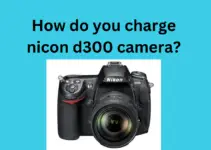Do Disposable Cameras Expire?
Have you ever wondered if disposable cameras have an expiration date?
These compact, pre-loaded cameras are perfect for capturing moments without worrying about settings or batteries.
However, like most photographic products, they aren’t immune to the passage of time. The film inside disposable cameras has a shelf life, and its quality can degrade if not stored properly.
Factors like heat, humidity, and prolonged exposure to light can all affect the camera’s performance. In this article, we’ll explore whether disposable cameras expire, what impacts their longevity, and how to ensure your memories are preserved with the best possible results.
Does dispable cameras expire?
Yes, disposable cameras do expire, primarily because of the film inside them. The film has a chemical composition that deteriorates over time, which can impact the quality of your photos.
Most disposable cameras come with an expiration date printed on the packaging, typically ranging from 1 to 3 years after manufacturing.

Once expired, the film may produce images with faded colors, lower contrast, or unpredictable light effects, often referred to as “film fog.” While some people find this vintage look appealing, it’s not ideal for all.
Storage conditions also play a crucial role in a camera’s longevity. Keeping disposable cameras in a cool, dry place can help extend their usability. Excessive heat, humidity, or direct sunlight can accelerate the film’s degradation, even before its expiration date.
For the best results, always check the expiration date and consider developing the photos as soon as possible after shooting.
What is dispable camera?
A disposable camera is a simple, pre-loaded film camera designed for single use.
It comes with a fixed amount of film, usually ranging from 24 to 39 exposures, and is fully self-contained, meaning you don’t need additional accessories like rolls of film or batteries (though some may include a built-in flash powered by a small battery).
These cameras are compact, lightweight, and easy to use, making them popular for casual photography, events, or travel. Users simply take their photos, and once all exposures are used, the entire camera is returned to a developer for processing.
Disposable cameras gained popularity in the late 20th century as an affordable and convenient option for photography.
While digital cameras and smartphones have largely replaced them, disposable cameras are still favored for their nostalgic appeal, unique film aesthetic, and reliability in situations where modern electronics might be impractical, such as outdoor adventures or underwater activities.
How long do disposable cameras last?
Disposable cameras typically last 1 to 3 years, depending on the expiration date of the film inside them. The film, not the camera itself, determines the camera’s longevity.
After the expiration date, the chemical composition of the film begins to degrade, which can result in faded colors, lower contrast, or grainy and unpredictable images.
Proper storage can significantly affect how long a disposable camera remains usable. Keeping the camera in a cool, dry place away from direct sunlight and high humidity helps preserve the film’s quality. Extreme temperatures, whether hot or cold, can accelerate degradation.
Even if the expiration date has passed, you can still use the camera, though the results may have a vintage or distorted look. For best results, use the camera before its expiration date and process the film shortly after taking the pictures to ensure the highest quality and sharpness in your photos.
Can you develop 20 year old disposable cameras?
Developing a 20-year-old disposable camera is possible, but the results may not be optimal. Over time, the film inside disposable cameras can deteriorate, which can lead to issues such as faded colors, graininess, or even complete image loss.
However, some old photos might still turn out well, depending on how the camera was stored and the quality of the film.
If you attempt to develop a 20-year-old disposable camera, the film may be more sensitive to light exposure, so it’s important to handle it carefully.
The chemicals in the film degrade over time, especially if the camera was kept in poor conditions (e.g., heat, humidity, or direct sunlight).
If you’re eager to see the results, it’s worth taking the camera to a professional photo lab that has experience handling old film. While the images might be unpredictable, you could still capture some surprising and nostalgic moments.
Can You Still Develop Old Disposable Cameras?
Yes, you can still develop old disposable cameras, but the results may vary depending on the age of the film and its storage conditions.
Disposable cameras typically have film with a shelf life of 1 to 3 years, but even after several years, you may still be able to develop the photos, especially if the camera was stored in a cool, dry place. However, film deterioration over time is inevitable, and it may lead to issues like faded colors, light leaks, graininess, or even complete image loss.
If the camera has been stored in extreme conditions (such as heat or humidity), the film may degrade more quickly, making it less likely to produce clear, sharp photos.
While the outcome is unpredictable, professional photo labs experienced with old film might still be able to develop it, offering a chance to recover some unique or nostalgic images from the past
Does unused camera film expire?
Yes, unused camera film does expire. Like all photographic materials, film has a shelf life, which is typically printed on the packaging.
The expiration date indicates when the film’s chemicals, such as the emulsions that capture images, begin to degrade. After the expiration date, the film may produce images with reduced quality, including color shifts, graininess, or even complete loss of detail.

The storage conditions of unused film play a significant role in its longevity. If kept in a cool, dry place away from direct sunlight and extreme temperatures, the film can remain usable for a longer period, even beyond its expiration date. However, storing film in warm, humid, or fluctuating temperatures can accelerate its deterioration.
While expired film can still be used, the results are often unpredictable. Some photographers intentionally use expired film to achieve a unique, vintage look, but it’s important to understand that the quality may be compromised.
Can disposable cameras be used again?
Disposable cameras are designed for single use, meaning they typically cannot be reused. Once the film inside the camera is fully exposed, the camera is intended to be discarded or returned to a photo lab for developing. The film is wound through the camera, and once all exposures are taken, it cannot be reloaded with more film.
The camera itself, however, could technically be reused in some cases. If you were to remove the used film and load the camera with new film (which would require a film roll with the same dimensions and loading mechanism), you could make the camera functional again. But this is not practical and could damage the camera or film, as disposable cameras are not designed for easy reloading.
For most people, it’s more cost-effective and hassle-free to purchase a new disposable camera rather than attempting to reuse an old one.
Dispable camera variations
Here’s a table outlining the different variations of disposable cameras:
| Variation | Description | Common Uses | Film Type | Flash | Exposure Range | Price Range |
|---|---|---|---|---|---|---|
| Standard Disposable Camera | Basic camera with pre-loaded film, typically with 24 or 36 exposures. | Casual events, travel, parties | Color or black & white | Built-in flash | Short distance (3-10 feet) | Low to moderate |
| Waterproof Disposable Camera | Waterproof cameras designed for use in wet environments such as pools, beaches, or underwater activities. | Swimming, diving, beach vacations | Color | Built-in flash | Short distance (3-10 feet) | Moderate |
| High-Performance Disposable Camera | Higher quality cameras with features like better lens or flash systems for clearer images in various lighting conditions. | Weddings, professional events | Color | Stronger built-in flash | Longer range (up to 15 feet) | Moderate to high |
| 360° Disposable Camera | Cameras designed to capture 360-degree panoramic photos in one shot. | Parties, outdoor events, travel | Color | Built-in flash | Wide angle (360°) | Moderate to high |
| Black and White Disposable Camera | Specially designed for black and white film, offering a classic, vintage look. | Artistic photography, events | Black & white | Built-in flash | Short to medium range | Low to moderate |
| Single-Use Camera with Flash | Basic disposable camera with a built-in flash for low-light photography. | Nighttime events, parties | Color | Built-in flash | Short distance (3-10 feet) | Low |
Each variation serves a specific need, whether it’s for special conditions like underwater photography or creating a specific visual effect like black-and-white images.
How to know if your dispable camera expire?
To know if your disposable camera has expired, follow these steps:

- Check the Packaging: Look for the expiration date printed on the box or label of the camera. Manufacturers usually provide this information, indicating when the film will start to degrade.
- Estimate the Age: If the expiration date is missing, consider how long you’ve had the camera. Disposable cameras typically last 1-3 years after manufacture.
- Inspect Storage Conditions: Think about where the camera has been stored. Exposure to heat, humidity, or sunlight can cause the film to degrade faster.
- Examine the Camera: If the camera feels damaged or the packaging is compromised, the film inside could be too.
- Test the Camera: The only way to know for sure is to use the camera and get the film developed. Results from expired film may vary, but it’s worth trying.
Related faq’s
What happens if you use an expired disposable camera?
Using an expired disposable camera can lead to unpredictable results.
As the film inside ages, its chemicals break down, causing issues such as faded colors, graininess, and light leaks. The images may appear blurry, with a noticeable loss in sharpness and contrast.
If the camera has been stored improperly, such as in warm or humid conditions, the film’s degradation will be accelerated.
Despite these potential problems, some photographers enjoy the vintage, imperfect look of expired film.
If you use an expired disposable camera, be prepared for lower quality, but also the possibility of unique, nostalgic images.
Can I get my disposable cameras developed with expired film? They’re about 10 years old and I want to see the old photos on there.
To know if your disposable camera has expired, check the packaging for an expiration date. Manufacturers typically print the expiration date on the camera’s box, which indicates when the film inside is expected to degrade. Most disposable cameras have a shelf life of about 1 to 3 years, but this can vary by brand and film type.
If you can’t find the expiration date, you can estimate the camera’s age by considering when it was purchased or how long it’s been sitting unused. Over time, the chemicals in the film begin to degrade, which can result in images with color shifts, increased grain, or faded details.
In addition to the expiration date, inspect the camera for any visible signs of damage, such as warped packaging or an unusual smell, which may indicate poor storage conditions. Storing the camera in a cool, dry place can help extend its usability, even after the expiration date.
When do disposable cameras expire?
Using an expired disposable camera can result in unpredictable photo quality. The film inside deteriorates over time, leading to faded colors, grainy images, or even complete loss of detail.
You might also experience light leaks, color shifts, or other visual distortions, depending on how long the camera has been expired. While some photographers enjoy these vintage, “imperfect” effects, the results may not be ideal for all situations.
Storage conditions, such as exposure to heat or humidity, can accelerate film degradation, so it’s important to handle expired cameras carefully to minimize further damage.
Can I get my disposable cameras developed with …
Yes, you can still get your 10-year-old disposable camera developed, even with expired film. However, the results may be unpredictable.
Over time, the film’s chemicals degrade, leading to faded colors, grainy images, or light leaks. Despite this, many photographers enjoy the unique, nostalgic look of expired film.
It’s best to take the camera to a professional lab that has experience with old film, as they can handle it carefully and potentially recover some of the images. While the quality may not be as high, there’s still a good chance you’ll uncover some memorable photos.
How long do used disposable cameras last for?
Once a disposable camera is used, its lifespan is typically short. After the film is fully exposed, the camera itself is meant to be discarded or sent for development.
The camera’s components, such as the film and internal mechanisms, can’t be reused. However, the physical camera body may last indefinitely if kept intact.
The real concern is the film’s expiration, which generally occurs 1 to 3 years after manufacture. After this period, the quality of photos may degrade due to the chemical breakdown of the film, affecting color, sharpness, and contrast.
How long do unused disposable cameras last?
Unused disposable cameras typically last 1 to 3 years before the film inside begins to degrade, as indicated by the expiration date printed on the packaging.
The shelf life depends on factors like the type of film, storage conditions, and brand. If stored in a cool, dry place away from heat and humidity, the film may last longer, but extreme temperatures or prolonged exposure to light can speed up deterioration.
After the expiration date, the film’s chemical properties break down, resulting in faded colors, graininess, and poor image quality. It’s best to use them before the expiration date for optimal results.
Will my disposable camera be any good past it’s expiration date?
Your disposable camera may still produce photos after its expiration date, but the quality could be compromised. As the film ages, its chemicals degrade, leading to potential issues like faded colors, grainy images, and unpredictable lighting effects.
Some people find this “vintage” look appealing, while others may not be satisfied with the results.
The camera’s storage conditions play a significant role—if it’s been stored in a cool, dry place, the film might still yield decent images, though you should expect some degradation. For the best results, try to use the camera before the expiration date.
Would the pictures on a 10 years expired disposable camera still be worth developing?
Pictures on a 10-year expired disposable camera may still be worth developing, but the results will be unpredictable.
The film’s chemical degradation over time can cause issues like faded colors, graininess, and light leaks. Some people enjoy the unique, nostalgic aesthetic of expired film, which can create interesting, vintage-style photos.
However, the quality won’t be as sharp or vibrant as fresh film. If the camera has been stored properly (cool and dry), you might still recover some memorable photos. It’s worth developing if you’re open to the possibility of surprises and enjoy the unpredictability of expired film.
Found an unopened 1998 disposable camera, will it still work or will the film be unusable?
A 1998 disposable camera is highly likely to have unusable film, as it’s been stored for over 25 years past its expiration date.
Film degrades over time, and after such a long period, the chemicals inside the film will likely have deteriorated, leading to faded colors, graininess, or complete image loss.
However, if the camera was stored in ideal conditions (cool, dry, and away from sunlight), there’s a slim chance it could still produce some usable images, though the quality will be unpredictable. If you’re curious, it’s worth developing the film, but don’t expect optimal results.
Expired Disposable Camera
An expired disposable camera may still function, but the quality of the photos is likely to be compromised.
The film inside degrades over time, especially past its expiration date, which is typically 1 to 3 years after manufacture. After expiration, you may experience issues like faded colors, graininess, or light leaks.
Despite these potential drawbacks, some photographers appreciate the vintage, unpredictable results of expired film. If the camera has been stored properly in a cool, dry place, you may still recover some unique or nostalgic images, but the overall quality will likely be lower than with fresh film.
Can I use disposable cameras which expired 20 years ago?
Using a disposable camera that expired 20 years ago is highly unlikely to yield usable results. After such a long period, the film’s chemicals have likely degraded significantly, leading to major issues like severe color fading, graininess, and possible image loss.
Even if the camera has been stored in ideal conditions (cool and dry), the chances of getting clear, vibrant photos are slim. While expired film can sometimes produce unique, vintage effects, 20 years past expiration generally results in poor quality. If you’re curious, it’s still worth developing, but don’t expect much from the photos.
Conclusion
In conclusion, disposable cameras do expire, and their film deteriorates over time.
While most disposable cameras are designed to be used within a few years of purchase, the film inside can begin to degrade after its expiration date, leading to faded colors, grainy images, and other quality issues. Storage conditions, such as heat and humidity, can accelerate this process.
Though you can still develop expired film, the results are unpredictable, and the quality is often compromised. To achieve the best possible results, it’s recommended to use disposable cameras before their expiration date.






